On Nov. 2, 2000, two days after blasting off from the Baikonur Cosmodrome in Kazakhstan, Expedition 1 crew members NASA astronaut William M. Shepherd and Russian Aviation and Space Agency, now Roscosmos, cosmonauts Yuri P. Gidzenko and Sergei K. Krikalev approached their destination, the International Space Station (ISS). After a successful docking, the crew transferred aboard the station and began bringing it to life. Their primary tasks during their four-month mission included installing and activating the life support and communications systems and working with three visiting space shuttle crews to continue the assembly of the ISS. The trio returned to Earth in March 2001 aboard space shuttle Discovery, having turned the ISS over to the Expedition 2 crew.

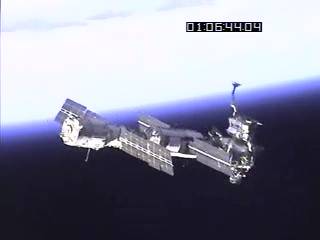

Three still images from a video of the International Space Station as it appeared to the Expedition 1 crew during the rendezvous and docking operation.
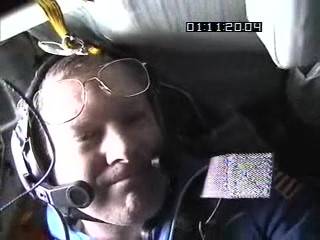


Left: NASA astronaut William M. Shepherd inside the Soyuz TM31 spacecraft during the rendezvous and docking operation with the International Space Station (ISS) (probably the first selfie of the ISS Program). Middle: Russian Aviation and Space Agency, now Roscosmos, cosmonauts Yuri P. Gidzenko, left, and Sergei K. Krikalev in the Soyuz spacecraft during the rendezvous with the ISS. Right: The three
crew members clasp hands after successfully docking with the ISS.
Gidzenko deftly guided their Soyuz TM31 spacecraft to a successful docking at the Zvezda Service Module’s aft port. The crew began equalizing the pressure between their spaceship and the ISS, and after some initial difficulties with opening the Soyuz orbital compartment hatch, they opened the first hatch to the ISS. As Shepherd filmed the event, Krikalev and Gidzenko entered Zvezda’s transfer chamber to await pressure equalization with the module’s main work compartment. Krikalev then opened the hatch and floated into Zvezda, turning lights on as he went, with Gidzenko and Shepherd following.



Left: Sergei K. Krikalev in the Soyuz orbital compartment equalizing the pressure between the spacecraft and the International Space Station’s Zvezda Service Module. Middle: Yuri P. Gidzenko and Krikalev opening the hatch of the Soyuz orbital compartment. Right: The Soyuz docking probe is visible after the orbital compartment hatch is open.


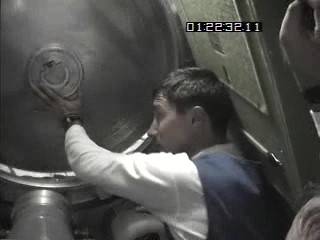
Left: Sergei K. Krikalev opening the first hatch of the International Space Station’s Zvezda Service Module that is also the docking probe. Middle: Krikalev, left, and Yuri P. Gidzenko in Zvezda’s transfer compartment awaiting the pressure equalization with the module’s main compartment. Right: Krikalev opening the hatch to Zvezda’s main compartment.
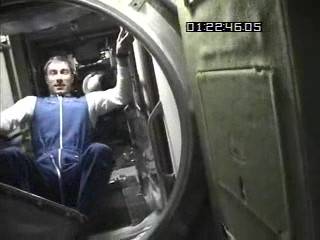
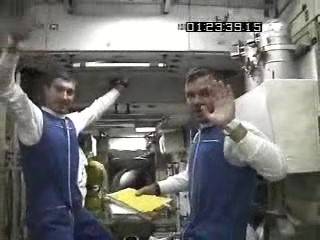

Left: Sergei K. Krikalev floating into the International Space Station’s Zvezda Service Module. Middle: With the lights in Zvevda turned on, Krikalev, left, and Yuri P. Gidzenko wave to the camera, operated by William M. Shepherd. Right: The toilet in Zvezda, with a sign left by the previous space shuttle visiting crew that read, “Sanitized for your safety and health by the crew of STS-106.”
Shortly after entering the station, Shepherd, Gidzenko, and Krikalev assembled in the work compartment to hold their first televised session with the Flight Control Center in Korolev, Russia, outside of Moscow. Flight controllers in the Mission Control Center at NASA’s Johnson Space Center in Houston monitored the event. The three spoke briefly with Russian Aviation and Space Agency General Director Yuri N. Koptev and NASA Administrator Daniel S. Goldin.


Left: The Expedition 1 crew of Sergei K. Krikalev, left, Yuri P. Gidzenko, and William M. Shepherd talking to the Flight Control Center in Korolev, Russia, outside of Moscow, from the International Space Station’s Zvezda Service Module. Right: NASA Administrator Daniel Golden speaking with the Expedition 1 crew from Russia’s Flight Control Center.
After the broadcast, it was time to get to work. The crew’s first tasks included the activation of the hot water dispenser, so they could enjoy a warm beverage, and the toilet. Over the next few days, Shepherd, Gidzenko, and Krikalev installed and activated the station’s critical systems such as the oxygen generation system and the carbon dioxide removal system. On Nov. 18, they welcomed their first Progress resupply craft that brought more than 5,000 pounds of cargo, water, and propellants to the ISS. When its automated rendezvous system malfunctioned, Gidzenko piloted it to a successful docking using a teleoperated system. Two weeks later, they greeted their first guests, the crew of the space shuttle Endeavour visiting the ISS on the STS-97 mission to install the station’s first truss segment, including the first solar arrays to provide power to the orbiting outpost. In February 2001, the STS-98 crew aboard Atlantis delivered the Destiny U.S. Laboratory Module, the primary American research facility. The following month, space shuttle Discovery arrived during the STS-102 mission with a Multi-Purpose Logistics Module delivering supplies and the first research rack to be installed in Destiny, the first Human Research Facility rack. Discovery brought Shepherd, Gidzenko, and Krikalev’s replacements to the ISS, the Expedition 2 crew of Russian cosmonaut Yuri V. Usachev and NASA astronauts James S. Voss and Susan J. Helms. The first expedition to the ISS ended after 141 days when Discovery touched down at NASA’s Kennedy Space Center on March 21, 2001.

The Expedition 1 crew of Yuri P. Gidzenko, left, William M. Shepherd, and Sergei K. Krikalev in the International Space Station’s Zvezda Service Module about one month into their four-month mission.
Enjoy a panel discussion reuniting the Expedition 1 crew with former director of NASA’s Johnson Space Center George W.S. Abbey and Expedition 1 Russian training integration instructor Ginger Kerrick, moderated by Jeanne Meserve.
The adventure continues…

























